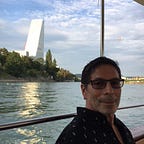Imagining MLK, Spinning in His Grave
Alphonso Johnson was a dark-skinned black boy, six years old, with a small, half-inch scar on his left cheek that I remember being the shape of the Number 2 pencils we used in our kindergarten class. One morning our teacher, Mrs. Glacken, didn’t like something Alphonso did. I can’t recall the specific infraction — maybe he said something to a classmate during the quiet period when we were supposed to be resting with our heads on our desks; or he was a second or two slow returning from the cloak room to his seat after recess — but whatever had set her off, it was minor. “Alphonso Johnson,” I can still hear her saying in a voice so mean it would make a watch dog cower. “You have that little tell-tale mark on your face. It’s always there and always will be, letting everyone know you’re just evil.”
Recognizing Bigotry
The me of today, looking back on that memory from 1956, recognizes my kindergarten teacher a racist and a bigot. There were several other black kids in that mostly white class of around 20 or 25. But I was the only Jew, and I felt as much like an outsider as anyone, although I was unable to understand or articulate those feelings until much later. They’ve lasted a lifetime and colored my view of the world.
In the course of my lifetime, I witnessed the stark segregation of the central New Jersey town where I was born. It was a place where colored people — long before they were called black, or African American, or people of color– lived in literal shanty towns and had almost no social interactions with whites. When I was 11, my family moved to Levittown, Pennsylvania, a suburb less than a half-hour from Philadelphia, where in 1957, the National Guard was brought in to keep the piece when riots broke out after the first black family moved in. White residents, as Ta-Nahisi Coates wrote in his acclaimed book on racism, “Bewteen the World and Me,” sought to keep Levittown legally segregated with an argument that went like this: “As moral, religious and law-abiding citizens, we feel that we are unprejudiced and undiscriminating in our wish to keep our community a closed community.”
The Least Racist Person You Ever Met
It sounds like they were the least racist people anyone ever met. Almost as nonracist as the President of the United States, and the neo-Nazis (at least some of them) he praised as “some very fine people” after last summer’s white supremacist demonstration in Charlottesville, South Carolina.
I don’t want to be thinking these unpleasant thoughts today of all days — Martin Luther King Jr.’s birthday. But I can’t help imagining the great civil rights leader spinning in his grave. As I write this essay, the TV news is on behind me, with another batch of commentators, pundits and congressional representatives excoriating, defending or claiming ignorance about President Trump’s remark over the weekend about African countries being “shit holes” or “shit houses,” take your pick.
Cue the people who wrote comments criticizing me the last time I posted something unfriendly about Trump on Linkedin, a little less than a year ago. It was right after a press conference in which the president showed patent ignorance and disrespect within the span of a few minutes to a senior African American journalist named April Ryan and an Orthodox Jewish White House correspondent named Jake Turx. A number of those reading my piece complained that it was inappropriate for a site like Linkedin that caters to professionals interested in networking and workplace issues.
Breaking the Workplace-Politics Barrier
But Trump nuked that barrier when he broke the cardinal corporate rule that treats diversity and inclusion as sacred precepts. Soon after Charlottesville, the distinguished and highly regarded CEO of Merck, Ken Frasier, an African-American whose grandfather was a slave, became the first business leader to resign from the president’s National Manufacturing Council, stating in a public declaration that “Our country’s strength stems from its diversity.” He went on, in words echoing MLK’s, “America’s leaders must honor our fundamental values by clearly rejecting expressions of hatred, bigotry and group supremacy, which run counter to the American ideal that all people are created equal.”
The CEOs of Intel and Under Armour, both white, followed Frazier out the door of the President’s Manufacturing Council, expressing their own disagreement with the views coming out of the White House. When a senior executive at my own former company, a bastion of conservatism, sent out a heart-felt employee announcement addressing the situation, I knew the boundary between politics and the work place had been breached.
“I’d like to recognize,” the CEO of one of the company’s key sites wrote, “that many of our colleagues may be affected quite significantly by some or all of these events — reopening old wounds; causing division among friends, family or the community; and raising anxiety or fear about the future.”
“The More Things Change…”
All of this sent me to the book store to read up on race relations in America. It’s been a recipe for deep depression. When James Baldwin wrote in “The Fire Next Time,” published in 1962, that every Negro boy needed to secretly fear an authority beyond his parents’ and capable of “mysterious and inexorable punishment,” and Ta-Nahisi Coates wrote in “Between the World and Me,” published in 2015, almost the same warning, in the form of a letter to his teenage son, what would Dr. Martin Luther King Jr. say on his birthday today? What questions would he ask? What would he think went wrong? And what would he advocate to fix it?
